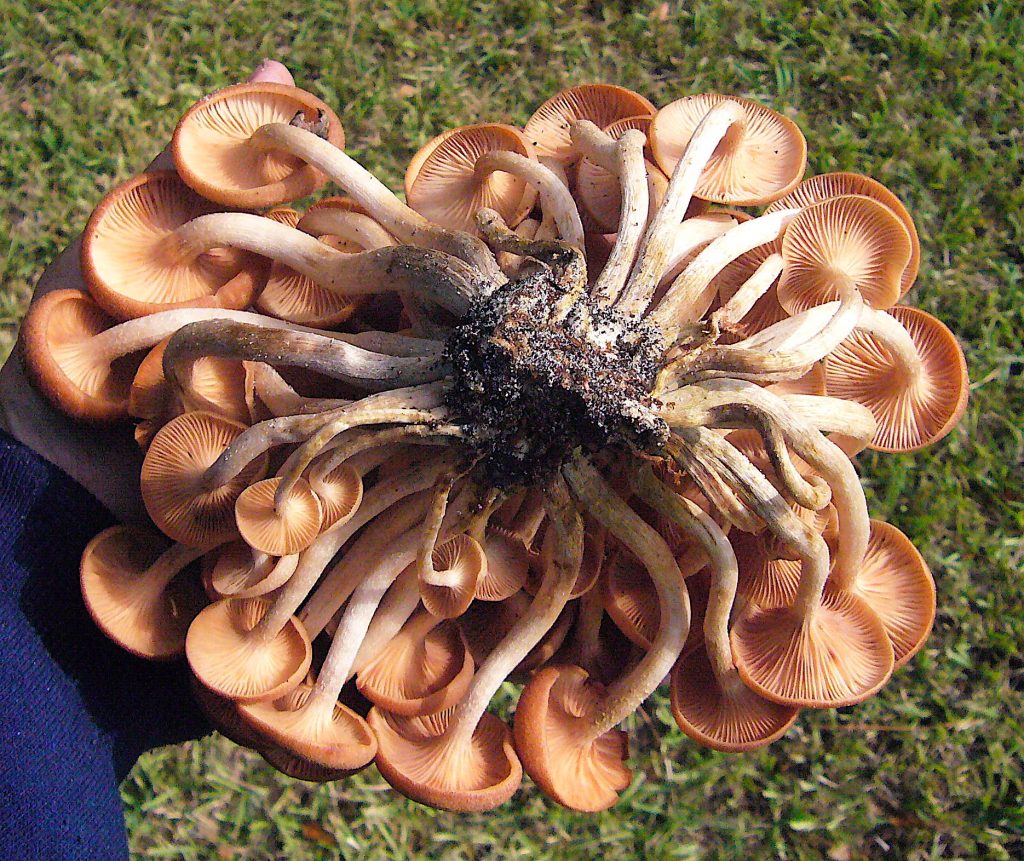
These prime Ringless Honey Mushrooms are cespitose, all growing out of one spot. Photo by Green Deane.
No one told the Ringless Honey Mushrooms it isn’t November. This controversial mushroom usually shows up in Central Florida during the first two weeks of the eleventh month. And, depending upon the weather, can have a minor flush in April or so. But we saw some Saturday in Blanchard Park east of Orlando and there have been sporadic reports of them on the Florida Mushroom Identification Forum. If you live farther north — Georgia, the Carolinas — now is the season to see them. Why are they controversial? Because some experts consider them “choice” eating and others view them as non-edible. I like them. I cook the young caps about twice as long as other mushrooms. To me they have a hint of maple syrup flavor. Some people can’t eat them unless they have been cooked twice. Without said they cause some digestive upset. And I know one person who can’t eat them even when cooked twice (such as parboiling then frying.) Usually the stems are not eaten but are used to make broth. Last year I dehydrated some 80 pounds of them. You can read about them here and watch my video here.
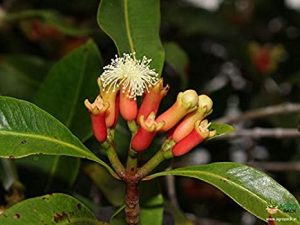
“Cloves” are the dried buds of a Syzygium.
A month ago we mentioned here that the Syzygiums were fruiting. That mostly included S. cumini also known as the Java Plum and Jambul. I’m making wine out of that. There are a few Jambuls in Orlando and certainly dozens in West Palm Beach. I know they also grow well in Sarasota and Port Charlotte where I think they are naturalized. Both Syzygium jambos and Syzygium samaragense are called the Rose Apple and Java Apple (and many other names as well.) There also is a Syzygium in your kitchen is S. aromaticum. You know the dried flower buds as “cloves.” As the species have been in foraging news lately I decided to bite the proverbial bullet and write a second article on the genus, or at least the latest one. You can read that article here and you can read about the Jambul here.

Classes are held rain or shine.
Last week the weather gods smiled favorably upon us. We did experience a few showers during our class in east Orlando but because of timing we found shelters to stay dry. Our fears that Sunday’s class in West Palm Beach would a rain out because of Hurricane Sally were unfounded. Not only did we not have any showers but it was lowery (overcast and cool) but had a nice breeze. It made for a very comfortable class. This week my foraging classes are in Gainesville and just south of Daytona Beach at Spruce Creek. There we might see blossoming Goji berries. It depends upon the weather.
Saturday September 19th, Boulware Springs Park, 3420 SE 15th St., Gainesville, FL 32641. 9 a.m. to noon. Meet at the picnic tables next to the pump house. (There may not be any bathrooms at this location so plan accordingly.)
Sunday September 20th, Spruce Creek Park, 6250 Ridgewood Ave. Port Orange, 32127. 9 a.m. to noon. Meet at the Pavilion.
Saturday, September 26th, George LeStrange Preserve, 4911 Ralls Road, Fort Pierce, FL, 34981, 9 a.m. to noon. This location does not have an official bathroom. Plan accordingly.
Sunday, September 27th, John Chestnut County Park: 2200 East Lake Road, Palm Harbor, FL 34685. 9 a.m. to noon. Meet at the trail head of the Peggy Park Nature Walk.
To learn more about the classes, to pre-pay, or sign up go here.
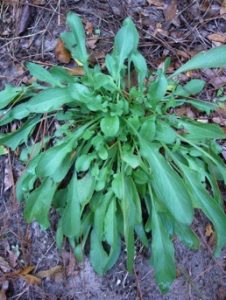
The leaves of Heartwing sorrel resemble a knife hilt. Photo by Green Deane
In some parts of the country fall is upon the landscape and final harvesting is underway before plants shut down for the winter. When I was a boy in Maine this meant scrumping apples and concord grapes. Locally our winter foraging season is just starting and while it is still warm one edible to start looking for is the Heartwing Sorrel. This tart Rumex is closely related to Sheep’s Sorrel — sometimes is called that — and is used the same way, usually as an addition to salads. This time of year there will be a plant here and a plant there. Look along grassy trails, pastures or fields particularly in northern areas. In a few months locally it can cover an entire field with a ruddy pink blanket of ripening seeds. To read more about the Heartwing Sorrel go here.
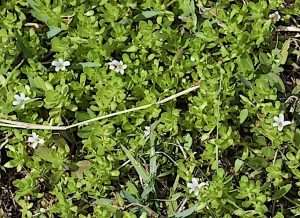
Bacopa blossoms all year but it likes the spring. Photo by Green Deane
There are six Bacopa in Florida but we are interested mainly in one, Water Hyssop, Bacopa monnieri. It’s a very bitter herb that looks like dwarf purslane except it’s all green. Water Hyssop has four- or five-petaled blossoms. They can be off-white, light blue or even light pink. You find the plant growing in damp or inundated areas. It is the only Bacopa with one crease on the back of its leaf. What’s interesting about Water Hyssop is that two different studies show it can increase memory function. The plant causes a gene to upregulate or “express itself.” This means the DNA in the gene can stretch, literally like a spring losing tension. This in turn causes the gene to make a protein. That protein causes the hippocampus to make new memory cells. It takes three months for the difference to be noticed. You can read about the Bacopas here and here.
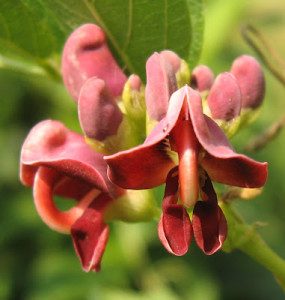
Ground Nut blossoms look pretty but smell bad.
Blossoming now and making it easy to spot are Ground Nuts, or Apios americana. This is a vine found in wet spots nearly everywhere east of the Rockies. It has clusters of maroon pea blossoms, which means “wings and keels.” The four petals of pea blossoms arrange themselves differently than most blossoms. Two flare out and two form together creating what looks like a boat’s keel and two wings. Grounds Nuts are a foraging staple and were also the second plant product exported from the New World to the Old World. The first was Sassafras wood. While we find Ground Nuts in damp spots they will happily grow in a regular garden producing edible tubers for many years. More to the point, once you know what the underground tubers look like you can easily identify them anywhere you find them. To learn more about Ground Nuts go here.

Green Deane videos are now available on a USB.
Changing foraging videos: My nine-DVD set of 135 videos has been selling for seven years and are still available. They are the same videos I have on You Tube. Some people like to have a separate copy. A second option is a16-gig USB that has those 135 videos plus 15 more. While the videos can be run from the DVDs the videos on the USB have to be copied to your computer to play. They are MP4 files. The150-video USB is $99 and the 135-video DVD set is now $99. The DVDs will be sold until they run out then will be exclusively replaced by the USB. This is a change I’ve been trying to make for several years. So if you have been wanting the 135-video DVD set order it now as the price is reduced and the supply limited. Or you can order the USB. My headache is getting my WordPress Order page changed to reflect these changes. We’ve been working on it for several weeks. However, if you want to order now either the USB or the DVD set make a $99 “donation” using the link at the bottom of this page or here. That order form provides me with your address, the amount — $99 — tells me it is not a donation and in the note say if you want the DVD set or the USB.

Green Deane Forum
Want to identify a plant? Perhaps you’re looking for a foraging reference? You might have a UFO, an Unidentified Flowering Object, you want identified. On the Green Deane Forum we — including Green Deane and others from around the world — chat about foraging all year. And it’s not just about warm-weather plants or just North American flora. Many nations share common weeds so there’s a lot to talk. There’s also more than weeds. The reference section has information for foraging around the world. There are also articles on food preservation, and forgotten skills from making bows to fermenting food.
This is weekly newsletter #423, If you want to subscribe to this free newsletter you can find the sign-up form in the menu at the top of the page.
To donate to the Green Deane Newsletter click here.


I understand that David Aurora peels the stems of the ringless honey mushroom and saute’s them along with the tops. I haven’t tried that yet but a bloom of honey’s has just arrived here in north Georgia so that will be on the agenda tomorrow.